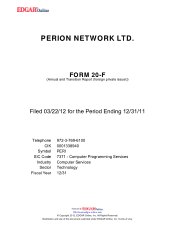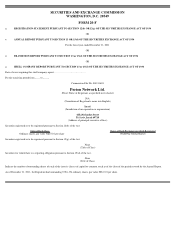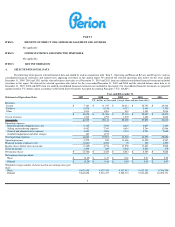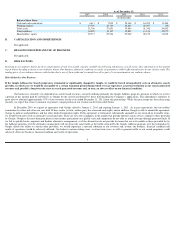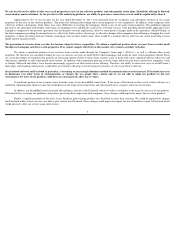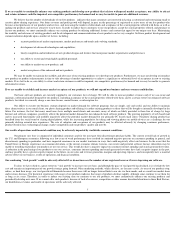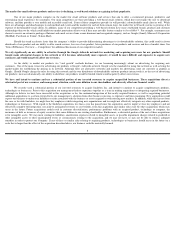Incredimail 2011 Annual Report Download - page 10
Download and view the complete annual report
Please find page 10 of the 2011 Incredimail annual report below. You can navigate through the pages in the report by either clicking on the pages listed below, or by using the keyword search tool below to find specific information within the annual report.
If we are unable to continually enhance our existing products and develop new products that achieve widespread market acceptance, our ability to attract
and retain customers could be impaired, our competitive position may be harmed and we may be unable to generate additional revenues.
We believe that the number of downloads of our free products
indicates that many consumers are interested in having a customized and entertaining email or
creative photo sharing experience. Our future revenue and profit growth will depend, in part, on the percentage of registered or active users of our free product who
become actual purchasers of our products and services, and increasing the number of downloads and acceptance of the search properties offered with them, as well as
making our products and services attractive to new users. In order to induce those consumers to use our products, accept the search properties offered, and purchase or
license our products, we must continually enhance our existing products by offering additional features and content that appeal to our unique user base. Maintaining
the usability and relevance of existing products and the development and commercialization of new products can be very complex. Software product development and
commercialization depends upon a number of factors, including:
We may be unable to maintain the usability and relevance of our existing products or to develop new products. Furthermore, we may not develop or introduce
new products or product enhancements in time to take advantage of market opportunities or achieve a significant or substantial level of acceptance in new or existing
markets. If we fail to do so, our ability to attract and retain customers could be impaired, our competitive position may be harmed and we may be unable to generate
substantial revenues.
If we are unable to establish and increase market acceptance of our products, we will not expand our business and our revenues could decline.
Our basic software products are currently supplied to our customers free of charge. We will be able to increase product revenues only if we can create and
maintain a substantial market demand for our products, including acceptance of the search properties offered with them, and to a certain extent our enhanced software
products, for which we currently charge a one-time license, annual license, or subscription fee.
Our ability to execute our business strategy depends on market demand for software programs that are simple, safe and useful, and our ability to maintain
these characteristics in our email client, our photo sharing product and offering it in other existing products or those that will be bought or internally developed in the
future. For instance, the fact that many email users have multiple email clients and accounts, many of which are likely provided to them free of charge by large
Internet and software companies, positively affects the potential market demand for our enhanced email software products. The growing popularity of web based mail
and its increased functionality and mobility negatively affect the potential market demand for our primarily PC based email client. Our photo sharing product has
benefited from the social trend of sharing digital photos, while the increasing popularity for taking and viewing photos on mobile devices are a challenge for our
primarily desktop oriented user experience. The rate of adoption and acceptance of our products may be affected adversely by changing consumer preferences,
product obsolescence, technological change, market competition and our products’ quality and novelty.
Our results of operations and financial condition may be adversely impacted by worldwide economic conditions.
Our primary user base is composed of individual consumers and for the most part their discretionary purchase habits. The current overall lack of growth in
the U.S. and European economies following on a few years of weak performance have resulted in continued negative pressure on consumer spending in general, and
discretionary spending in particular, and have impacted consumers in our market territories in ways that could negatively affect our business. In the event that the
United States or Europe experiences an economic downturn, or the current economic climate worsens, our current and potential software license subscribers may be
unable or unwilling to purchase our products or use our service. This would also have a negative impact on consumer internet spending and search generated revenues.
A reduction in the purchasing of our products or use our services, consumer internet spending and search generated revenues have had a negative impact in the past,
and may possibly have a greater negative impact in the future, on our sales and revenue generation, margins and operating expenses, and consequently have a material
adverse effect on our business, results of operations and financial condition.
Our continuing "viral growth" could be adversely affected if we do not increase the number of our registered users or if users stop using our software.
To date, we have relied to a great extent on "viral growth" to increase our user base, and although the pace of viral growth has declined, it is of relatively low
cost and remains an important part of our growth strategy going forward. Other marketing methods, while effective, are far more costly. As users of our products stop,
reduce, or limit their usage, our viral growth will diminish because these users will no longer forward links to our site via their emails, and as a result our market share
and revenues decrease. Our historical experience with usage of our products indicates that usage of products declines rapidly, although some continue to use them for
as long as six years. Therefore, in order to induce our existing users to continue to use our products, we must continuously enhance our existing products and
periodically develop new ones. If we cannot offer such products, because of lack of resources, competition or other reasons described elsewhere in these Risk Factors,
our distribution, revenues and results of operations will be adversely affected.
•
accurate prediction of market requirements, market preferences and trends and evolving standards;
•
development of advanced technologies and capabilities;
•
timely completion and introduction of new product designs and features that incorporate market requirements and preferences;
•
our ability to recruit and retain highly qualified personnel;
•
our ability to market our new products; and
•
market acceptance of the enhanced and new products.
7

